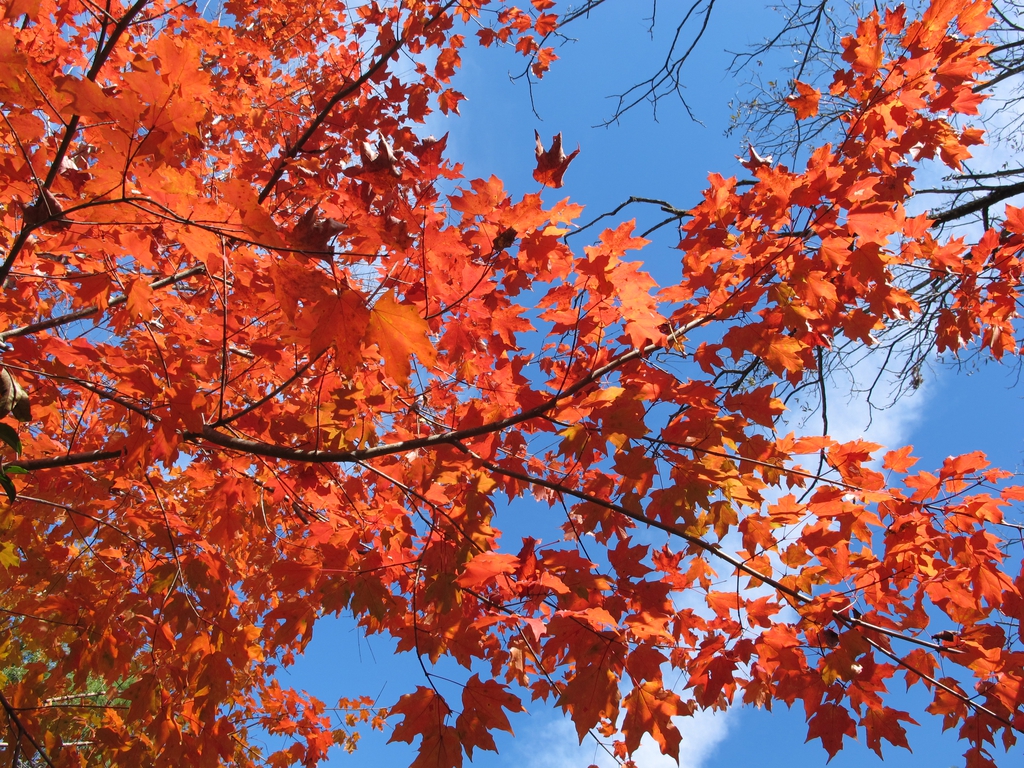Chalk Maple Acer saccharum subsp. leucoderme
Other Common Name(s):
Previously known as:
- Acer leucoderme
- Phonetic Spelling
- AY-ser sah-KAY-rum loo-koh-DERM
- Description
-
Chalk maple is a small "version" of a sugar maple tree in the Sapindaceae (soapberry) family with an oval to rounded crown. In nature, it can be found in rocky slopes and bluffs, particularly over mafic or calcareous rock. The name "chalk maple" (in addition to the Latin name, meaning "white skin") comes from the attractive smooth and thin chalky white or light gray bark on mature trees. The bark becomes ridged and blackish at the base as it ages.
Plant in full sun to partial shade in moist, well-drained soil. The tree will often grow multi-stemmed unless trimmed as single stem style when young.
Insects, Diseases, and Other Plant Problems: No serious problems. See potential disease and insect problem fact sheets to the left.
The Clemson Cooperative Extension Home and Garden Information Center has a factsheet on common maple diseases and insect pests.
- See this plant in the following landscape:
- Cultivars / Varieties:
-
- Tags:




















- Cultivars / Varieties:
-
- Tags:
-
-
Attributes:
- Genus:
- Acer
- Species:
- saccharum subsp. leucoderme
- Family:
- Sapindaceae
- Uses (Ethnobotany):
- Shade trees, bonsai, maple syrup.
- Life Cycle:
- Woody
- Recommended Propagation Strategy:
- Seed
- Country Or Region Of Origin:
- Native (USA)
- Distribution:
- Southeast; TX to NC and south to northwest FL
- Wildlife Value:
- Members of the genus Acer support Imperial Moth (Eacles imperialis) larvae which have one brood per season and appear from April-October in the south. Adult Imperial Moths do not feed. Early spring source of nectar for bees. The seeds are eaten by birds and small mammals. Butterflies and other pollinating insects enjoy the nectar from the flowers.
- Play Value:
- Attracts Pollinators
- Shade
- Wildlife Food Source
- Particularly Resistant To (Insects/Diseases/Other Problems):
- Pest free, highly shade and drought tolerant, and heat tolerant
-
-
Whole Plant Traits:
- Plant Type:
- Native Plant
- Tree
- Woody Plant Leaf Characteristics:
- Deciduous
- Habit/Form:
- Multi-stemmed
- Oval
- Rounded
- Growth Rate:
- Slow
- Texture:
- Medium
-
-
Cultural Conditions:
- Light:
- Deep shade (Less than 2 hours to no direct sunlight)
- Full sun (6 or more hours of direct sunlight a day)
- Partial Shade (Direct sunlight only part of the day, 2-6 hours)
- Soil Drainage:
- Good Drainage
- Moist
- Occasionally Dry
- NC Region:
- Mountains
- Piedmont
- USDA Plant Hardiness Zone:
- 5a, 5b, 6a, 6b, 7a, 7b, 8a, 8b, 9a, 9b
-
-
Fruit:
- Fruit Color:
- Brown/Copper
- Display/Harvest Time:
- Fall
- Spring
- Summer
- Fruit Type:
- Samara
- Fruit Length:
- < 1 inch
- Fruit Description:
- The fruit is a paired brown samara, less than an inch long, with a 50 to 60 degree angle maturing in autumn. In North Carolina, samaras are available from May to September.
-
-
Flowers:
- Flower Color:
- Gold/Yellow
- Green
- Flower Inflorescence:
- Corymb
- Raceme
- Umbel
- Flower Bloom Time:
- Spring
- Winter
- Flower Description:
- Regular & pentamerous. In North Carolina, the greenish-yellow flowers are available from March to April.
-
-
Leaves:
- Woody Plant Leaf Characteristics:
- Deciduous
- Leaf Color:
- Gold/Yellow
- Green
- Orange
- Deciduous Leaf Fall Color:
- Gold/Yellow
- Orange
- Red/Burgundy
- Leaf Type:
- Compound (Pinnately , Bipinnately, Palmately)
- Simple
- Leaf Arrangement:
- Opposite
- Leaf Margin:
- Lobed
- Hairs Present:
- Yes
- Leaf Length:
- 1-3 inches
- Leaf Width:
- 1-3 inches
- Leaf Description:
- Opposite, simple leaves; brilliant yellow-orange to cardinal crimson fall color.
-
-
Bark:
- Bark Color:
- Black
- Light Gray
- White
- Bark Description:
- Pale gray to chalky white bark on upper part of trunk. The bark becomes ridged and blackish at the base as it ages.
-
-
Stem:
- Stem Color:
- Brown/Copper
- Red/Burgundy
- Stem Is Aromatic:
- No
- Stem Buds:
- Hairy tips
- Stem Surface:
- Smooth (glabrous)
- Stem Description:
- Fine, reddish brown, with vertical lenticels. Essentially glabrous.
-
-
Landscape:
- Landscape Location:
- Lawn
- Naturalized Area
- Pond
- Slope/Bank
- Woodland
- Landscape Theme:
- Drought Tolerant Garden
- Native Garden
- Nighttime Garden
- Pollinator Garden
- Shade Garden
- Design Feature:
- Shade Tree
- Understory Tree
- Attracts:
- Bees
- Butterflies
- Moths
- Pollinators
- Small Mammals
- Songbirds
- Resistance To Challenges:
- Drought
- Heat
- Insect Pests







